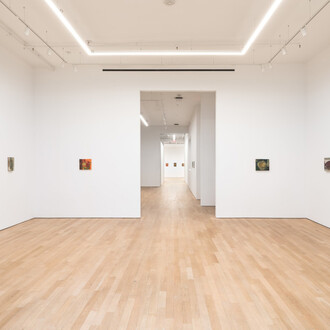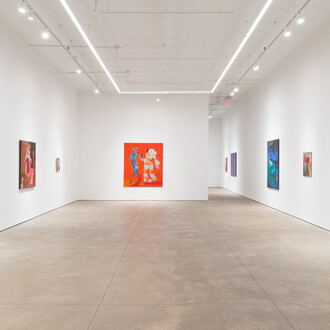PPOW is pleased to present Carlos Motta: Conatus, the artist’s second solo show with the gallery. Comprising new work in several media, the exhibition is grouped in three sections: a trio of related videos, a series of photographs, and a cycle of framed objects that traffic in appropriation and assemblage. Latin for ‘striving, endeavor, inclination,’ ‘conatus’ means the desire of each person or thing to persist in itself. In Motta’s new work, subjects persist and even thrive amid the legacy of historical trauma.
Motta’s multilayered 24-minute video Corpo Fechado: The Devil’s Work (2018) screens in the first room. It relates the true story of Francisco José Pereira, an 18th century man who was kidnapped from West Africa and sold into slavery in Brazil. As a means of survival, Pereira along with others in enslaved communities developed syncretic spiritual practices that mixed African with Christian tradition, notably in the form of bolsas de mandinga — amulets to protect fellow enslaved persons from injury. In 1731, after Pereira was sold to a slaveholder in Portugal, the Lisbon Inquisition tried him for sorcery. He was also charged with sodomy, since he confessed to copulating with male demons in the course of making the amulets. He was exiled from Lisbon, condemned to end his days enslaved in a galley. Corpo Fechado imagines Pereira as the agent of his own narrative, reclaiming the terms of representation from the account of his own destruction.
The video interweaves Pereira’s story, drawn from court documents, with two other texts. The first is Letter 31 – The Book of Gomorrah, an 11th century screed by the Italian monk Peter Damian (now a saint), which laid significant foundations for Christianity’s millennium of persecuting so-called sodomites. The discourse of the sodomite also played a central role in European colonialism, a theme Motta has extensively explored in earlier video works like Nefandus Trilogy (2013) and the installation Towards a Homoerotic Historiography (2014), currently on view in the exhibition Home is a Foreign Place at The MET Breuer. Damian stalks the film as a robed and faceless menace, in one scene playing chess with a Portuguese conquistador. The second intertext is Walter Benjamin’s famed Theses on the Philosophy of History (1940). In Corpo Fechado, Pereira incarnates Benjamin’s Angel of History, a seraph caught in a storm blowing from Paradise, propelled inexorably into the future yet facing backward, doomed to see only the wreckage of the past. To paraphrase Benjamin, Corpo Fechado grasps the constellation our present era forms with definite earlier ones. It uncovers messianic struggle from the shadows of history.
Pereira is played movingly by the actor Paulo Pascoal, the subject of a video interview also on view. Well-known in his home country of Angola, Pascoal worked for years in New York before moving back across the Atlantic. When he came out as gay in a 2014 TEDxLuanda talk, however, Pascoal received death threats and was forced to relocate once again. He now resides in Lisbon where he is trapped in a sort of immigration limbo, unable to re-enter Portugal should he ever leave. With uncanny fidelity, the biography of the actor therefore resonates with the life of his character, mutatis mutandis, crisscrossing oceans of both water and time in spectral fulfillment of Benjamin’s historical method.
A third video, We the Enemy (2019), plays in the side gallery, the latest fruits of the collective known as SPIT! (Sodomites, Perverts, and Inverts Together!), which includes Motta, John Arthur Peetz, and Carlos Maria Romero. In the video, Greek artist Despina Zacharopoulou performs their manifesto We the Enemy (2017), a compendium of slurs for queerfolk of various ilks and eras. They range from backhanded benignities (‘golden boys,’ ‘fishy girls’) to capital offenses (‘AIDS carriers,’ ‘degenerates’), from the charmingly obscure (‘Ursulas,’ ‘Uranians’) to the oppressively everyday (‘faggots,’ ‘dykes,’ ‘he-shes’). Like the angelic Pereira, who also lists a litany of calumnies he once bore, the queers of SPIT! Reclaim the terms that sought to injure them, transfiguring hate into defiant power: a queer ‘conatus.’ “We,” they proclaim, “are and will always be the enemy.”
The Enemy is also the subject of a new series of photographs in the central gallery space, whose full title cites the opening lines of Dante’s Inferno: Midway upon the journey of our life/ I found myself within a forest dark, / For the straightforward pathway had been lost (2019). Within a void of black, serpents strike poses with a disembodied hand or a fetish-masked head. A snake wreathes the head like a crown of thorns, or loops through fingers like some runic monogram. Deceptive in their simplicity, each parselmouth part-object sibilates Satanic susurrations, bedeviling distinctions of good and evil. These spirits, though fallen, do not despair — there is pleasure in the dark.
Motta’s perverted path finally bends into PPOW’s Viewing Room, where objects arrayed like a museum-display hover somewhere between fetish and artifact. Black monochrome abounds. At center lies Senhor Morto (2019), the dismembered bronze body of Christ submerged in water. On surrounding walls, whips, knots, and rings suggest sacred mysteries, occult sex, alchemical orders, and other arcana. The room is peppered with art historical allusion, as in the black-mirrored reference to Robert Mapplethorpe’s Self-Portrait with Whip (1978). Inverting Benjamin’s dictum, these works turn documents of barbarism into documents of civilization, and instruments of punishment into accoutrements of ecstasy.
If ‘conatus’ is about persistence and desire, Conatus marshals all the powers of the night for the effort. It unearths avenging angels beneath the wreckage of history. Mingling testimony of the vanquished with the diatribes of their oppressors, Motta converts histories of suffering into a shrewd and often playful aesthetic of defiance. Rejecting nihilism, Motta embraces (with Benjamin) ‘courage, humor, cunning, and fortitude.’ Even in the darkest of times, Conatus affirms the desire to persist.
















